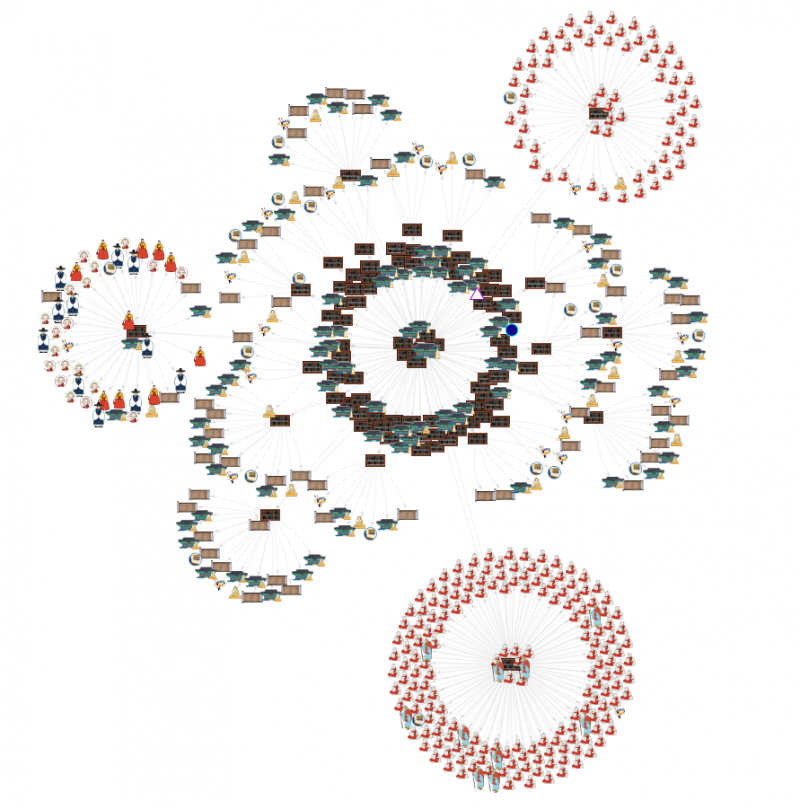Introduction
avatamsakasutra
- Focusing on the Avatamsaka Sutra of the Tripitaka Koreana -
| KIM Soo-hyeon Major in Cultural Informatics The Graduate School of Korean Studies The Academy of Korean Studies |
This research seeks a method for exploring and reading Buddhist scriptures via today’s digital media. It does so by devising a method to visually express the semantic relations and the key literary elements of the Gandavyuha and Dasabhumika Sutras, both found in the Avatamsaka Sutra of the Tripitaka Koreana.
In Korea, in order to digitize the texts of Buddhist scriptures, the analogue characters of classical Chinese and old Hangeul were transformed into digital text that followed the Unicode standard. An example of this research is the digital Tripitaka Koreana of the Archives of Buddhist Culture (Dongguk University). In order to preserve the original form of the scriptures, the database was designed to reflect the way the Tripitaka Koreana scriptures were stored and arranged at the time they were compiled. During the process of digitizing the characters into Unicode, nearly 70,000 variants and typographical errors in the original text were accurately included.
Regarding these kinds of efforts to digitize Buddhist scriptures, Kim Jong-myung (2002) has argued that the content of Buddhist scriptures should not simply be copied as-is from woodblock to CD, but that there is a need for the addition of new documents.
In order to fully understand the teachings of the Buddha, there is a need for the Buddhist scriptures to be copied from analogue to digital text and to digitize the work of preserving and passing down the teachings and, moreover, the knowledge in which the true teachings of Buddhism are inherent.
With these issues in mind, this research selected the Avatamsaka Sutra, which is a Buddhist scripture included in the Tripitaka Koreana, as the main text of study. In order to develop a new data model for the digitization of the text of the Buddhist scripture, the structure and context of the Gandavyuha and Dasabhumika Sutras were comprehensively reviewed. Through the reading of information about the elements that form the context, Gandavyuha Sutra Story Visualization Data was created in order to approach the detailed information related to the Avatamsaka Sutra. A semantic database, named the Avatamsaka Sutra Digital Archive, was created based upon a newly designed Gandavyuha Ontology (gdvh). This archive consists of the following parts: the Gandavyuha Sutra Document Data Index, the Gandavyuha Sutra Story Visualization Data, the VR Gallery of the Illustrations of the Avatamsaka Sutra, and the Gandavyuha Sutra Digital Dictionary of People and Terms. The Ganavyuha Ontology aims to convey the semantic relationships between the Gandavyuha and Dasabhumika Sutras. Based on this ontology, the semantic relationships between the knowledge elements related to the Sudhana’s quest for enlightenment in the Gandavyuha Sutra and the knowledge elements related to the teachings of the masters in the Dasabhumika Sutra were visually expressed so that the story structure of the Avatamsaka Sutra can be clearly observed from a comprehensive perspective.
The Avatamsaka Sutra Digital Archive is provided to users via an online platform based on Wiki software. Through the Gandavyuha Sutra Document Data Index, the Gandavyuha Sutra can be browsed based on volume and Buddhist master in Sanskrit, English, Chinese, Japanese, and Korean. An index for each volume is provided so that, while browsing the Buddhist scriptures, the knowledge elements for each volume can be searched visually. The Gandavyuha Sutra Story Visualization Data shows the overall knowledge elements for the Gandavyuha Sutra and the detailed story elements related to Sudhana’s quest for enlightenment based on the Gandavyuha Ontology. This kind of knowledge information, including information relating to Buddhist masters, dharma texts, and teaching venues, are provided via hyperlink together with the respective Buddhist scripture and a VR space which shows illustrations of the Avatamsaka Sutra. In the VR Gallery of the Illustrations of the Avatamsaka Sutra, the illustrations of the Avatamsaka Sutra can be browsed by each volume. Information related to the various people depicted in the illustrations can be accessed via hyperlinked icons which connect to the Gandavyuha Sutra Digital Dictionary of People and Terms.
Through this, the users can understand diverse variations that comprise the original character of the Buddhist scriptures and the context that is communicated among them. By seeking a new method for approaching the digitalization of the text of Buddhist scriptures, there is the possibility of exploring new knowledge and literary elements contained within the Avatamsaka Sutra.
Keywords: Tripitaka Koreana, Illustration of the Avatamsaka Sutra, Gandavyuha Sutra, Dasabhumika Sutra, digital Buddhism dictionary, digital humanities, ontology, digital archive
